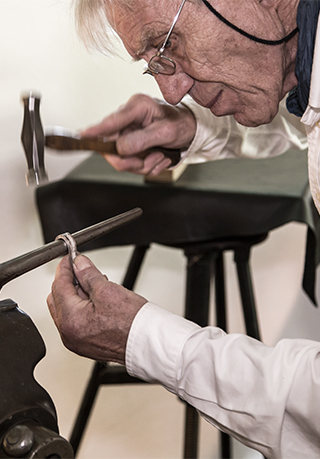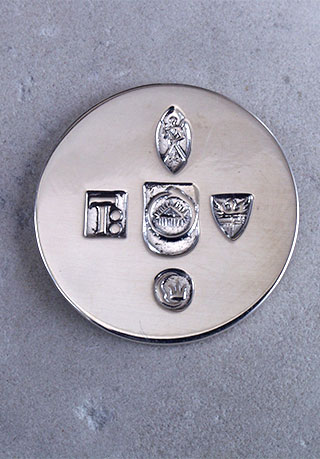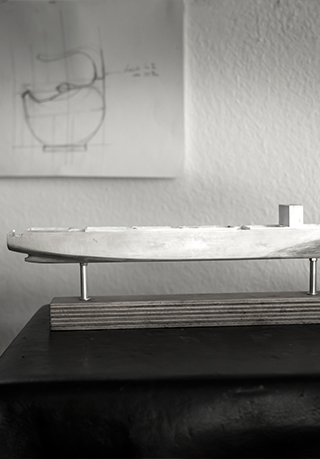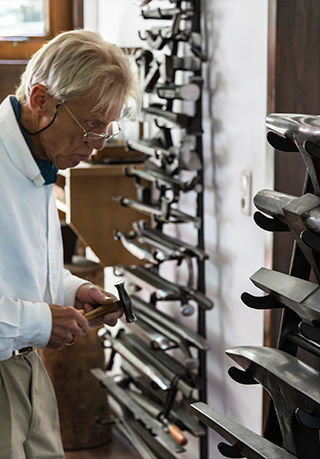
On the patience of the hand
In 'Crowds and Power', Elias Canetti examines grasping as an act of power and comes to the conclusion that the true glory of the hand is in its patience: 'It is the quiet, prolonged activities of the hand that have created the world in which we care to live.'
This image is appropriate to the work of the gold and silversmith Thore Blume. His hands are instruments of an extraordinary, personal sensibility, with the apparent instinctive knowledge of how the piece of jewellery or the utensil in question should appear, reconciling form and function in an energetic exchange. When the form arises from the function, the piece becomes a utensil, and when the function arises from the form, the result is a piece of jewellery.
The hands don't work alone in this process; rather they seek a dialogue with the eyes. Both interact with thought and memory.

'The culture of thought presupposes a veritable culture of the hand, an understanding of the hand as a subtle, sensitive organ, that if allowed to unfold — to not only work but also to play, to observe — in turn allows the spirit to flourish. The work of the hand is that of the mind. The concept is grasped by the hand.' (Otl Aicher, Robert Kuhn).
The work of the smith is physical. The hammer beats down, the punch chases and shapes: a rhythmic process persists until new life has entered the material.
In the repair of jewellery, gold and silver are placed in juxtaposition with precious stones. Their magical past is revealed. The mesmerising effect that results lends them even today an auratic character, evoking visual metaphors:
Tourmaline glows in every colour imaginable in response to the metals enclosed within it. A remarkable quality of beryl is its astounding clarity. Opals are perhaps the most mysterious of the precious stones; they shine as if their walls imprison the very genesis of colour. These visual metaphors perpetuate an ongoing dialogue with the wearer of the jewellery.
In 1856, two years before the founding of Th. Blume's gold and silversmith's workshop in Hildesheim, the architect and art historian Gottfried Semper gave a lecture on the formal design of jewellery and its meaning as an artistic symbol that can still be read today. He divides jewellery into the following categories:
- Hanging jewellery, which observes symmetry, such as earrings.
- Ring jewellery, highlighting the proportions of the body and
- Directional jewellery, emphasising the movement of the body, such as the brooch.

Of the many materials, forms and surface qualities arise bangles, necklaces, brooches and rings. Surface quality is of great importance. The lustre creates reflections which grant the piece a semblance of weightlessness and luminescence. As such, the lustre removes any severity the form might have and replaces this with lightness. One first begins to understand the work of the smith when one considers that the most decisive aspect of the work that is done must remain imperceptible, as Paul Valéry observes, 'good machines don't make a sound'.
This is an apt metaphor for the work of the silversmith. Take for example how one experiences the beauty of a jug: I see it, I touch it. If it's empty, I fill it, I take it by the curved handle, lift it up, tilt it over the cup and pour. All the while I am observing. And the jug serves to provide the drink.

It stands apart from industrially manufactured objects that most often resemble a caricature rather than an accurate copy. These are characterised by a minimum of presence, a vacancy of form. By contrast, the very fingerprint of the gold and silversmith is left upon his work: A lively and pleasing exchange between beauty and practicality takes place. Here is the form of the jug: Body, spout, handle and lid. The various functions are reconciled in a single, integral form. Traces of the smith's hand can either be eliminated or only coarsely filed so that they remain visible. The rolling and hammering indentations, visible marks of the craft of silver rolling, either remain or are polished away. The elaborate process of repairing silverware, requiring an unending patience of the hand, remains visible. Whereas industrial design reveals only a lack of personality; it is subject to the primacy of its function, and its appearance is derived from this relationship. Silverware by Thore Blume possesses an aura that transcends norms and habit – one might also call this his style or personal signature.
It gives hope that this craft may stand up to industrial manufacturing even as the future looms.
It is, as such, necessary to forge modern collaborations such as that between Thore Blume and silver manufacturer Koch & Bergfeld Corpus in Bremen. Noteworthy pieces have already come about through this collaboration, such as the creation of scale 1:500 model ships, based on the original blueprints.
Th. Blume's 150-year history is characterised by a longevity, a creation in lightness arising from the skill and the craft of the gold and silversmith. As to the future, this is the realm of the fifth generation.
Text: Jörg Henning Kokott
